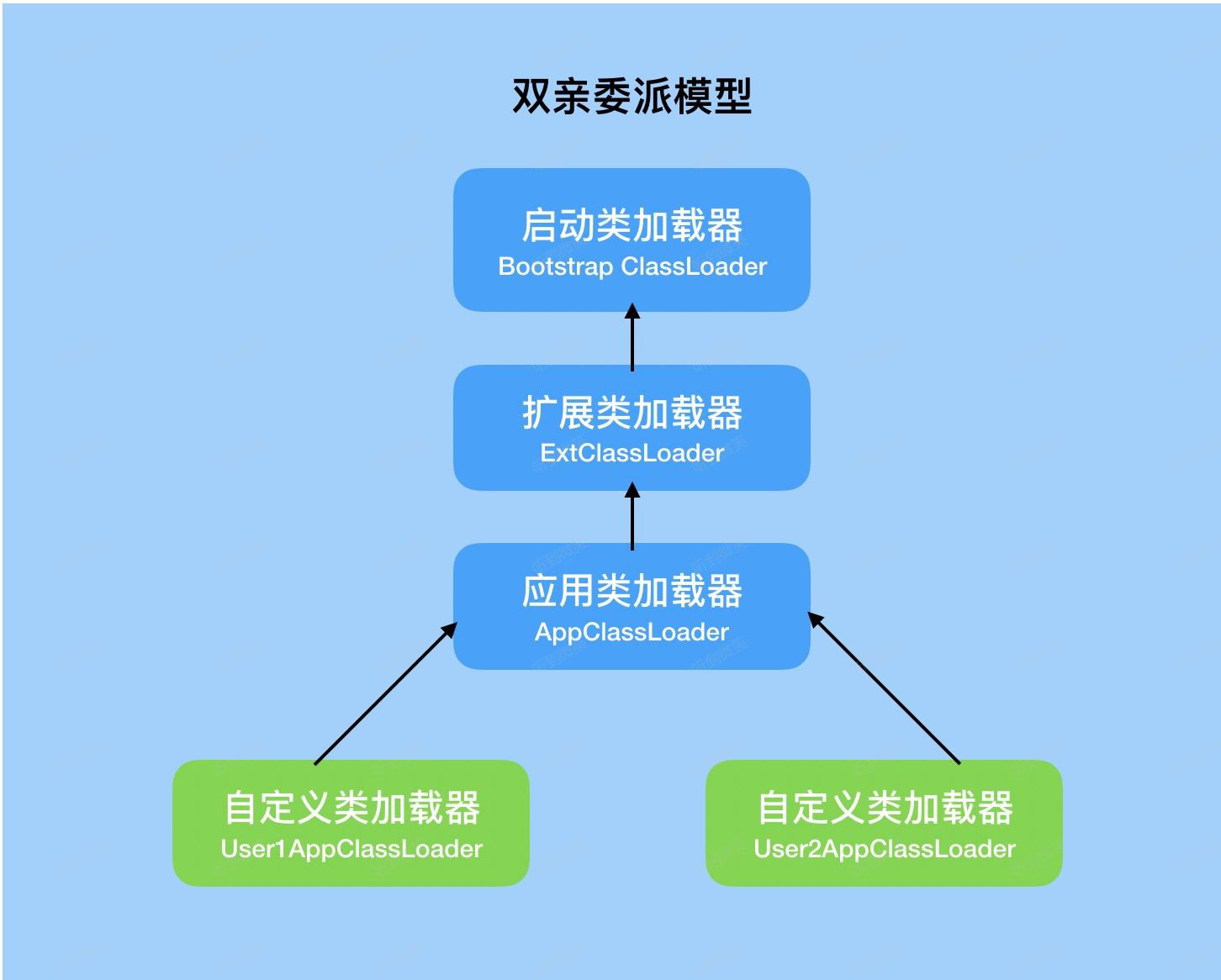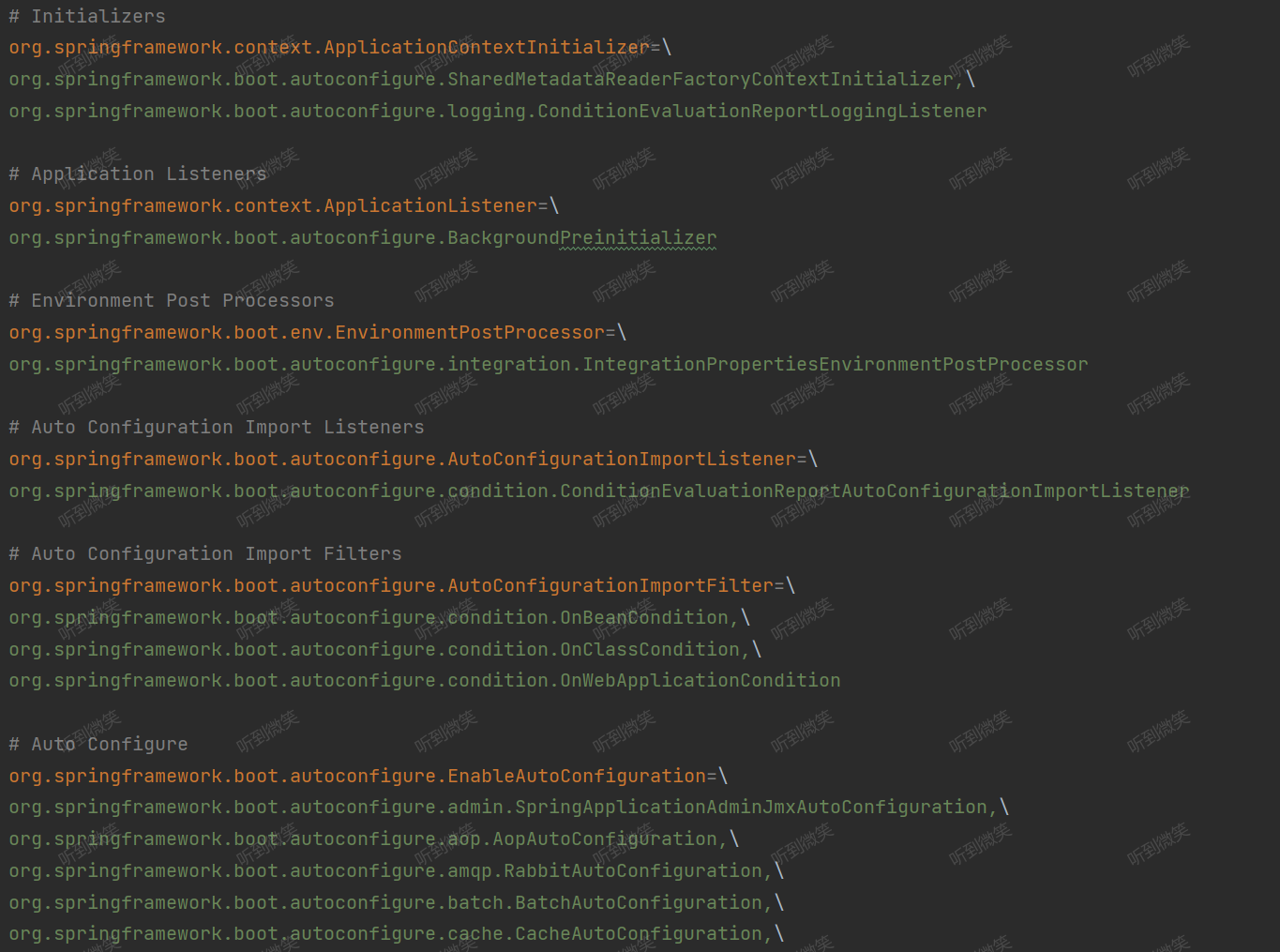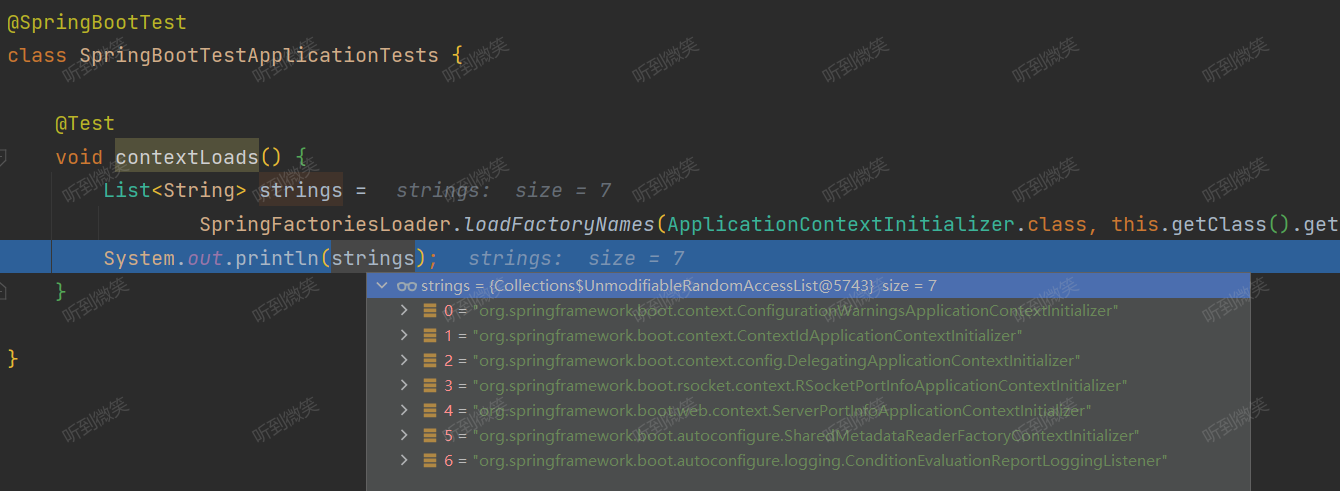详解Spring SPI机制
一. 从类加载说起
Java中的类加载器负载加载来自文件系统、网络或者其他来源的类文件。jvm的类加载器默认使用的是双亲委派模式。三种默认的类加载器Bootstrap ClassLoader、Extension ClassLoader和System ClassLoader(Application ClassLoader)每一个中类加载器都确定了从哪一些位置加载文件。于此同时我们也可以通过继承 java.lang.classloader 实现自己的类加载器。
Bootstrap ClassLoader:负责加载JDK自带的rt.jar包中的类文件,是所有类加载的父类
Extension ClassLoader:负责加载java的扩展类库从jre/lib/ect目录或者java.ext.dirs系统属性指定的目录下加载类,是System ClassLoader的父类加载器
System ClassLoader:负责从classpath环境变量中加载类文件

1.1 双亲委派
当一个类加载器收到类加载任务时,会先交给自己的父加载器去完成,因此最终加载任务都会传递到最顶层的BootstrapClassLoader,只有当父加载器无法完成加载任务时,才会尝试自己来加载。
根据双亲委派模式,在加载类文件的时候,子类加载器首先将加载请求委托给它的父加载器,父加载器会检测自己是否已经加载过类,如果已经加载则加载过程结束,如果没有加载的话则请求继续向上传递直Bootstrap ClassLoader。如果请求向上委托过程中,如果始终没有检测到该类已经加载,则Bootstrap ClassLoader开始尝试从其对应路劲中加载该类文件,如果失败则由子类加载器继续尝试加载,直至发起加载请求的子加载器为止。
采用双亲委派模式可以保证类型加载的安全性,不管是哪个加载器加载这个类,最终都是委托给顶层的BootstrapClassLoader来加载的,只有父类无法加载自己猜尝试加载,这样就可以保证任何的类加载器最终得到的都是同样一个Object对象。
protected Class<?> loadClass(String name, boolean resolve) {
synchronized (getClassLoadingLock(name)) {
// 首先,检查该类是否已经被加载,如果从JVM缓存中找到该类,则直接返回
Class<?> c = findLoadedClass(name);
if (c == null) {
try {
// 遵循双亲委派的模型,首先会通过递归从父加载器开始找,
// 直到父类加载器是BootstrapClassLoader为止
if (parent != null) {
c = parent.loadClass(name, false);
} else {
c = findBootstrapClassOrNull(name);
}
} catch (ClassNotFoundException e) {}
if (c == null) {
// 如果还找不到,尝试通过findClass方法去寻找
// findClass是留给开发者自己实现的,也就是说
// 自定义类加载器时,重写此方法即可
c = findClass(name);
}
}
if (resolve) {
resolveClass(c);
}
return c;
}
}
1.2 双亲委派模型的缺陷
在双亲委派模型中,子类加载器可以使用父类加载器已经加载的类,而父类加载器无法使用子类加载器已经加载的。这就导致了双亲委派模型并不能解决所有的类加载器问题。
案例:Java 提供了很多服务提供者接口(Service Provider Interface,SPI),允许第三方为这些接口提供实现。常见的 SPI 有 JDBC、JNDI、JAXP 等,这些SPI的接口由核心类库提供,却由第三方实现,这样就存在一个问题:SPI 的接口是 Java 核心库的一部分,是由BootstrapClassLoader加载的;SPI实现的Java类一般是由AppClassLoader来加载的。BootstrapClassLoader是无法找到 SPI 的实现类的,因为它只加载Java的核心库。它也不能代理给AppClassLoader,因为它是最顶层的类加载器。也就是说,双亲委派模型并不能解决这个问题
1.3 使用线程上下文类加载器(ContextClassLoader)加载
如果不做任何的设置,Java应用的线程的上下文类加载器默认就是AppClassLoader。在核心类库使用SPI接口时,传递的类加载器使用线程上下文类加载器,就可以成功的加载到SPI实现的类。线程上下文类加载器在很多SPI的实现中都会用到。
通常我们可以通过Thread.currentThread().getClassLoader()和Thread.currentThread().getContextClassLoader()获取线程上下文类加载器。
1.4 使用类加载器加载资源文件,比如jar包
类加载器除了加载class外,还有一个非常重要功能,就是加载资源,它可以从jar包中读取任何资源文件,比如,ClassLoader.getResources(String name)方法就是用于读取jar包中的资源文件
//获取资源的方法
public Enumeration<URL> getResources(String name) throws IOException {
Enumeration<URL>[] tmp = (Enumeration<URL>[]) new Enumeration<?>[2];
if (parent != null) {
tmp[0] = parent.getResources(name);
} else {
tmp[0] = getBootstrapResources(name);
}
tmp[1] = findResources(name);
return new CompoundEnumeration<>(tmp);
}
它的逻辑其实跟类加载的逻辑是一样的,首先判断父类加载器是否为空,不为空则委托父类加载器执行资源查找任务,直到BootstrapClassLoader,最后才轮到自己查找。而不同的类加载器负责扫描不同路径下的jar包,就如同加载class一样,最后会扫描所有的jar包,找到符合条件的资源文件。
// 使用线程上下文类加载器加载资源
public static void main(String[] args) throws Exception{
// Array.class的完整路径
String name = "java/sql/Array.class";
Enumeration<URL> urls = Thread.currentThread().getContextClassLoader().getResources(name);
while (urls.hasMoreElements()) {
URL url = urls.nextElement();
System.out.println(url.toString());
}
}
二. Spring中的SPI机制
2.1 Spring中SPI的使用
在Spring中提供了SPI机制,我们只需要在 META-INF/spring.factories 中配置接口实现类名,即可通过服务发现机制,在运行时加载接口的实现类:
org.springframework.boot.autoconfigure.EnableAutoConfiguration=\
org.springframework.boot.autoconfigure.admin.SpringApplicationAdminJmxAutoConfiguration
在 spring-boot-autoconfigure 模块下,SpringBoot默认就配置了很多接口的服务实现:

配置好 spring.factories 文件后,我们就可以通过 SpringFactoriesLoader 动态加载接口实现类了,代码如下:
List<String> strings = SpringFactoriesLoader.loadFactoryNames(ApplicationContextInitializer.class, this.getClass().getClassLoader());
System.out.println(strings);
我们在引入 spring-boot-starter-web 模块时,应用环境就配置了6个 ApplicationContextInitializer接口实现类:

2.2 SpringFactoriesLoader API
org.springframework.core.io.support.SpringFactoriesLoader就是Spring框架中的“ServiceLoader”,该类提供了下列功能:
-
类静态成员常量
final String FACTORIES_RESOURCE_LOCATION = "META-INF/spring.factories"
此常量定义了该工具类要从每个jar包中提取的工厂类定义属性文件的相对路径。 -
类静态方法
<T> List<T> loadFactories(Class<T> factoryClass, ClassLoader classLoader)
此方法会读取classpath上所有的jar包中的所有META-INF/spring.factories属性文件,找出其中定义的匹配类型 factoryClass 的工厂类,然后创建每个工厂类的对象/实例,并返回这些工厂类对象/实例的列表。 -
类静态方法
List<String> loadFactoryNames(Class<?> factoryClass, ClassLoader classLoader)
此方法会读取classpath上所有的jar包中的所有META-INF/spring.factories属性文件,找出其中定义的匹配类型 factoryClass 的工厂类,然后并返回这些工厂类的名字列表,注意是包含包名的全限定名。
2.3 SpringFactoriesLoader 源码
本源码基于 spring-framework 5.3.10 版本分析:
/**
* General purpose factory loading mechanism for internal use within the framework.
* 用于框架内部使用的通用工厂加载机制。
*
* <p>{@code SpringFactoriesLoader} {@linkplain #loadFactories loads} and instantiates
* factories of a given type from {@value #FACTORIES_RESOURCE_LOCATION} files which
* may be present in multiple JAR files in the classpath. The {@code spring.factories}
* file must be in {@link Properties} format, where the key is the fully qualified
* name of the interface or abstract class, and the value is a comma-separated list of
* implementation class names. For example:
*
* SpringFactoriesLoader#loadFactories设计用于加载和实例化指定类型的工厂,这些工厂类型的定义
* 来自classpath中多个JAR包内常量FACTORIES_RESOURCE_LOCATION所指定的那些spring.factories文件。
* spring.factories文件的格式必须是{@link Properties}格式,每条属性的key必须是接口或者抽象类的全限定名,
* 而属性值value是一个逗号分割的实现类的名称。
*
* <pre class="code">example.MyService=example.MyServiceImpl1,example.MyServiceImpl2</pre>
*
* where {@code example.MyService} is the name of the interface, and {@code MyServiceImpl1}
* and {@code MyServiceImpl2} are two implementations.
*
* @author Arjen Poutsma
* @author Juergen Hoeller
* @author Sam Brannen
* @since 3.2
*/
public final class SpringFactoriesLoader {
/**
* The location to look for factories.
* <p>Can be present in multiple JAR files.
*
* 在classpath中的多个JAR中要扫描的工厂配置文件的在本JAR包中的路径。
* 实际上,Springboot的每个 autoconfigure包都包含一个这样的文件。
*/
public static final String FACTORIES_RESOURCE_LOCATION = "META-INF/spring.factories";
private static final Log logger = LogFactory.getLog(SpringFactoriesLoader.class);
/**
* 缓存,在 loadFactoryNames 首次被调用时,所有jar包中的 META-INF/spring.factories
* 文件内容都会被加载,然后缓存在 cache 中, 注意 cache Map 的 key 是 loadFactoryNames
* 调用时的参数 classLoader, 而 value 是另外一个 Map,其 key 是工厂类的名称,
* 也就是每个 META-INF/spring.factories 属性文件中属性名部分
*/
static final Map<ClassLoader, Map<String, List<String>>> cache = new ConcurrentReferenceHashMap<>();
private SpringFactoriesLoader() {
}
/**
* Load and instantiate the factory implementations of the given type from
* {@value #FACTORIES_RESOURCE_LOCATION}, using the given class loader.
* <p>The returned factories are sorted through {@link AnnotationAwareOrderComparator}.
* <p>If a custom instantiation strategy is required, use {@link #loadFactoryNames}
* to obtain all registered factory names.
* <p>As of Spring Framework 5.3, if duplicate implementation class names are
* discovered for a given factory type, only one instance of the duplicated
* implementation type will be instantiated.
* @param factoryType the interface or abstract class representing the factory
* @param classLoader the ClassLoader to use for loading (can be {@code null} to use the default)
* @throws IllegalArgumentException if any factory implementation class cannot
* be loaded or if an error occurs while instantiating any factory
* @see #loadFactoryNames
*/
public static <T> List<T> loadFactories(Class<T> factoryType, @Nullable ClassLoader classLoader) {
Assert.notNull(factoryType, "'factoryType' must not be null");
ClassLoader classLoaderToUse = classLoader;
if (classLoaderToUse == null) {
classLoaderToUse = SpringFactoriesLoader.class.getClassLoader();
}
// 加载类型为factoryClass的工厂的名称,其实是一个个的全限定类名,使用指定的classloader:
List<String> factoryImplementationNames = loadFactoryNames(factoryType, classLoaderToUse);
if (logger.isTraceEnabled()) {
logger.trace("Loaded [" + factoryType.getName() + "] names: " + factoryImplementationNames);
}
List<T> result = new ArrayList<>(factoryImplementationNames.size());
// 实例化所加载的每个工厂类
for (String factoryImplementationName : factoryImplementationNames) {
result.add(instantiateFactory(factoryImplementationName, factoryType, classLoaderToUse));
}
// 排序
AnnotationAwareOrderComparator.sort(result);
return result;
}
/**
* Load the fully qualified class names of factory implementations of the
* given type from {@value #FACTORIES_RESOURCE_LOCATION}, using the given
* class loader.
* <p>As of Spring Framework 5.3, if a particular implementation class name
* is discovered more than once for the given factory type, duplicates will
* be ignored.
* @param factoryType the interface or abstract class representing the factory
* @param classLoader the ClassLoader to use for loading resources; can be
* {@code null} to use the default
* @throws IllegalArgumentException if an error occurs while loading factory names
* @see #loadFactories
*/
public static List<String> loadFactoryNames(Class<?> factoryType, @Nullable ClassLoader classLoader) {
ClassLoader classLoaderToUse = classLoader;
if (classLoaderToUse == null) {
classLoaderToUse = SpringFactoriesLoader.class.getClassLoader();
}
String factoryTypeName = factoryType.getName();
// 1. 使用指定的classloader扫描classpath上所有的JAR包中的文件META-INF/spring.factories,加载其中的多值
// 工厂属性定义,使用多值Map的形式返回,
// 2. 返回多值Map中key为factoryClassName的工厂名称列表,如果没有相应的entry,返回空列表而不是返回null
return loadSpringFactories(classLoaderToUse).getOrDefault(factoryTypeName, Collections.emptyList());
}
/**
* 使用指定的classloader扫描classpath上所有的JAR包中的文件META-INF/spring.factories,加载其中的多值
* 工厂属性定义,使用多值Map的形式返回
**/
private static Map<String, List<String>> loadSpringFactories(ClassLoader classLoader) {
Map<String, List<String>> result = cache.get(classLoader);
if (result != null) {
return result;
}
result = new HashMap<>();
try {
// 扫描classpath上所有JAR中的文件META-INF/spring.factories
Enumeration<URL> urls = classLoader.getResources(FACTORIES_RESOURCE_LOCATION);
while (urls.hasMoreElements()) {
// 找到的每个META-INF/spring.factories文件都是一个Properties文件,将其内容
// 加载到一个 Properties 对象然后处理其中的每个属性
URL url = urls.nextElement();
// url 对应某个 META-INF/spring.factories 配置文件资源
UrlResource resource = new UrlResource(url);
// properties 来自 url 对应某个 META-INF/spring.factories 配置文件资源
Properties properties = PropertiesLoaderUtils.loadProperties(resource);
for (Map.Entry<?, ?> entry : properties.entrySet()) {
// 获取工厂类名称(接口或者抽象类的全限定名)
String factoryTypeName = ((String) entry.getKey()).trim();
// 将逗号分割的属性值逐个取出,然后放到多值Map结果result中去。
String[] factoryImplementationNames =
StringUtils.commaDelimitedListToStringArray((String) entry.getValue());
for (String factoryImplementationName : factoryImplementationNames) {
// 放到 result 中 :
// key 使用 factoryClassName
// value 可能有多值, 使用 factoryName
result.computeIfAbsent(factoryTypeName, key -> new ArrayList<>())
.add(factoryImplementationName.trim());
}
}
}
// Replace all lists with unmodifiable lists containing unique elements
result.replaceAll((factoryType, implementations) -> implementations.stream().distinct()
.collect(Collectors.collectingAndThen(Collectors.toList(), Collections::unmodifiableList)));
// 放到缓存中,key 使用 classLoader
cache.put(classLoader, result);
}
catch (IOException ex) {
throw new IllegalArgumentException("Unable to load factories from location [" +
FACTORIES_RESOURCE_LOCATION + "]", ex);
}
return result;
}
/**
* @param factoryImplementationName 工厂实现类全限定名称
* @param factoryType 工厂所属接口/抽象类全限定名称
* @param classLoader 所要使用的类加载器
**/
@SuppressWarnings("unchecked")
private static <T> T instantiateFactory(String factoryImplementationName, Class<T> factoryType, ClassLoader classLoader) {
try {
Class<?> factoryImplementationClass = ClassUtils.forName(factoryImplementationName, classLoader);
if (!factoryType.isAssignableFrom(factoryImplementationClass)) {
throw new IllegalArgumentException(
"Class [" + factoryImplementationName + "] is not assignable to factory type [" + factoryType.getName() + "]");
}
return (T) ReflectionUtils.accessibleConstructor(factoryImplementationClass).newInstance();
}
catch (Throwable ex) {
throw new IllegalArgumentException(
"Unable to instantiate factory class [" + factoryImplementationName + "] for factory type [" + factoryType.getName() + "]",
ex);
}
}
}
2.4 SpringFactoriesLoader 的应用
Spring Boot提供的一些JAR包,里面会带有文件META-INF/spring.factories。Spring Boot应用启动的时候,根据启动阶段不同的需求,框架就会调用SpringFactoriesLoader加载相应的工厂配置信息。
比如SpringBoot应用使用了注解@EnableAutoConfiguration时,就会触发对SpringFactoriesLoader.loadFactoryNames()的调用。
除此之外,SpringBoot还会对外提供其它的扩展点,下面列举了部分常见的扩展点
// SpringApplication.initialize
// => SpringApplication.getSpringFactoriesInstances()
SpringFactoriesLoader.loadFactoryNames(org.springframework.context.ApplicationContextInitializer)
// SpringApplication.initialize
// => SpringApplication.getSpringFactoriesInstances()
SpringFactoriesLoader.loadFactoryNames(org.springframework.context.ApplicationListenr)
// SpringApplication.run
// => getRunListeners
// => SpringApplication.getSpringFactoriesInstances()
SpringFactoriesLoader.loadFactoryNames(org.springframework.boot.SpringApplicationRunListener)
// SpringApplication.run
// => prepareEnvironment
// => SpringApplication.getSpringFactoriesInstances()
// => ConfigFileApplicationListener.onApplicationEnvironmentPreparedEvent() //事件处理
// => loadPostProcessors()
SpringFactoriesLoader.loadFactoryNames(org.springframework.boot.env.EnvironmentPostProcessor)
我们就以 ApplicationContextInitializer 为例,分析一下在SpringBoot中 ApplicationContextInitializer 扩展点的加载时机。
SpringBoot启动是直接使用 main 方法启动,程序入口一目了然,对源码阅读比较友好,下面是一个SpringBoot应用标准的启动代码:
SpringApplication.run(SpringBootTestApplication.class, args);
我们从 run 方法入手:
public static ConfigurableApplicationContext run(Class<?> primarySource, String... args) {
// <1> 调用重载run方法
return run(new Class<?>[] { primarySource }, args);
}
public static ConfigurableApplicationContext run(Class<?>[] primarySources, String[] args) {
// <2> 创建,并初始化SpringApplication实例,并调用run方法,启动容器
return new SpringApplication(primarySources).run(args);
}
首先是连续两个重载的静态run方法,静态run方法内部会调用构造方法实例化SpringApplication对象,再调用一个成员方法run()来正式启动。
public SpringApplication(ResourceLoader resourceLoader, Class<?>... primarySources) {
this.resourceLoader = resourceLoader;
Assert.notNull(primarySources, "PrimarySources must not be null");
this.primarySources = new LinkedHashSet<>(Arrays.asList(primarySources));
this.webApplicationType = WebApplicationType.deduceFromClasspath();
this.bootstrapRegistryInitializers = new ArrayList<>(
getSpringFactoriesInstances(BootstrapRegistryInitializer.class));
// <3> 通过SPI机制,加载classpath环境中配置的ApplicationContextInitializer实现类,并实例化
setInitializers((Collection) getSpringFactoriesInstances(ApplicationContextInitializer.class));
// <4> 通过SPI机制,加载classpath环境中配置的ApplicationListener实现类,并实例化
setListeners((Collection) getSpringFactoriesInstances(ApplicationListener.class));
this.mainApplicationClass = deduceMainApplicationClass();
}
在调用构造器实例化SpringApplication时,会通过SPI机制,加载classpath环境中配置的ApplicationContextInitializer实现类,并实例化:
private <T> Collection<T> getSpringFactoriesInstances(Class<T> type) {
return getSpringFactoriesInstances(type, new Class<?>[] {});
}
private <T> Collection<T> getSpringFactoriesInstances(Class<T> type, Class<?>[] parameterTypes, Object... args) {
// 获取当前线程的classLoader
ClassLoader classLoader = getClassLoader();
// Use names and ensure unique to protect against duplicates
// <1> 加载指定类型对应的,在 `META-INF/spring.factories` 里的类名的数组
Set<String> names = new LinkedHashSet<>(SpringFactoriesLoader.loadFactoryNames(type, classLoader));
// <2> 创建对象
List<T> instances = createSpringFactoriesInstances(type, parameterTypes, classLoader, args, names);
// <3> 排序对象
AnnotationAwareOrderComparator.sort(instances);
return instances;
}
三. SpringBoot2.7.0 自动配置将不推荐使用spring.factories
SpringBoot 2.7 中,不再推荐使用/META-INF/spring.factories文件作为自动配置类的配置文件,所以对于有自定义Starter的开发者来说,有时间要抓紧把这一变化改起来了,因为在SpringBoot 3开始将移除对/META-INF/spring.factories的支持。

如果您已经创建了自动配置,那么应该将注册从META-INF/spring.factories转移到一个名为META-INF/spring/org.springframework.boot.autoconfigure.AutoConfiguration.imports的新文件。每一行都包含自动配置的完全限定名。请参考: the included auto-configurations
为了向后兼容,spring.factories 的功能仍将暂时支持。
本文参考至:
